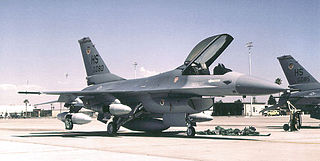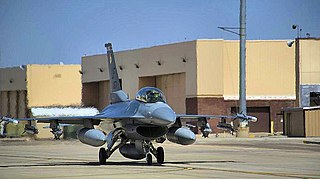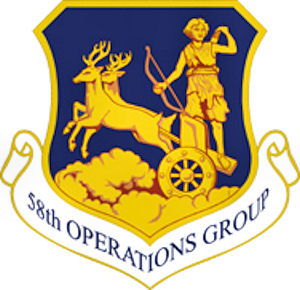
Luke Air Force Base is a United States Air Force base in Maricopa County, Arizona, United States. It is located 7 miles west of the central business district of Glendale, and 15 miles west of Phoenix.

The 65th Aggressor Squadron is a United States Air Force unit currently operating the F-35A Lightning II. It is assigned to the 57th Operations Group at Nellis Air Force Base, Nevada.

The 58th Special Operations Wing is a combat unit of the United States Air Force stationed at Kirtland Air Force Base, New Mexico. The 58 SOW is part of the Air Education and Training Command (AETC) Nineteenth Air Force.

The 388th Fighter Wing (388FW) is a United States Air Force unit assigned to the Air Combat Command Fifteenth Air Force. The unit is stationed at Hill Air Force Base, Utah.

The 188th Rescue Squadron is unit of the New Mexico Air National Guard. It is assigned to the 150th Special Operations Wing located at Kirtland Air Force Base, New Mexico.

The 36th Fighter Squadron is part of the US Air Force's 51st Operations Group at Osan Air Base, South Korea. It operates the General Dynamics F-16 Fighting Falcon aircraft conducting air superiority missions. The squadron was first activated in 1917 as the 36th Aero Squadron and served in France during World War I, although the war ended before the unit saw combat. It has been continuously active since 1930 as a fighter squadron.

The 61st Fighter Squadron is an active United States Air Force unit, assigned to the 56th Operations Group, at Luke Air Force Base, Arizona. It operates the F-35 Lightning II aircraft, conducting Pilot training.

The 62d Fighter Squadron is part of the United States Air Force 56th Operations Group at Luke Air Force Base, Arizona. It operates the Lockheed Martin F-35A Lightning II aircraft conducting advanced fighter training.

The 63d Fighter Squadron is an active United States Air Force unit, assigned to the 56th Operations Group, at Luke Air Force Base, Arizona. It operates the F-35A aircraft, and conducts advanced fighter training since its reactivation in 2016. When this Squadron was reactivated in 1975, their mission was to train pilots and weapons systems officers for the McDonnell F-4E Phantom II, and they switched to the F-4D in 1978.

The 69th Fighter Squadron is a United States Air Force Reserve fighter squadron. It is assigned to the 944th Operations Group, stationed at Luke Air Force Base, Arizona.

The 308th Fighter Squadron is an active United States Air Force unit. It is part of the 56th Operations Group at Luke Air Force Base, Arizona, where it trains pilots on the Lockheed Martin F-35A.

The 309th Fighter Squadron is part of the 56th Operations Group at Luke Air Force Base, Arizona. It operates the General Dynamics F-16 Fighting Falcon aircraft conducting advanced fighter training.

The 311th Fighter Squadron (Sidewinders) is part of the 54th Fighter Group at Holloman Air Force Base, New Mexico which is a geographically separated unit under the 56th Fighter Wing at Luke Air Force Base, Arizona. It operates the General Dynamics F-16 Fighting Falcon aircraft conducting advanced fighter training. The squadron previously operated the Fighting Falcon conducting advanced fighter training at Luke and was inactivated due to budget constraints after the end of the Cold War. It was recently reactivated at Holloman and the aircraft were received from the 309th Fighter Squadron.

The 425th Fighter Squadron is part of the 56th Operations Group at Luke Air Force Base, Arizona. It operates the General Dynamics F-16 Fighting Falcon aircraft conducting advanced fighter training for Republic of Singapore Air Force F-16 pilots.

The 418th Test and Evaluation Squadron is an active United States Air Force unit assigned to the 53rd Test and Evaluation Group, and stationed at Davis-Monthan Air Force Base, Arizona, where it was activated on 1 October 2021.

The 56th Operations Group is a unit of the United States Air Force, and the flying component of the 56th Fighter Wing.

The 461st Flight Test Squadron is a United States Air Force squadron, assigned to the 412th Operations Group of Air Force Materiel Command, and is stationed at Edwards Air Force Base, California. The Squadron performs flight testing on the Lockheed Martin F-35 Lightning II.

The 48th Operations Group is the flying component of the 48th Fighter Wing, assigned to the United States Air Forces in Europe – Air Forces Africa. The group is stationed at RAF Lakenheath, England.

The 58th Operations Group is the operational flying component of the United States Air Force 58th Special Operations Wing. It is stationed at Kirtland Air Force Base, New Mexico.

The 312th Fighter Squadron is an active United States Air Force unit, stationed at Luke Air Force Base, Arizona. Its last previous assignment was with the 58th Tactical Training Wing at Luke, where it was inactivated on 18 January 1991. Upon inactivation, the squadron's personnel, equipment and aircraft were transferred to the 311th Fighter Squadron.






























